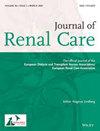Clinical Assessment of Fluid Status in Adults With Acute Kidney Injury: A Scoping Review
Abstract
Background
Acute kidney injury refers to sudden, potentially reversible, reduction in kidney function. Hypovolaemia is commonly the major risk factor. When acute kidney injury is established, fluid can accumulate leading to fluid overload. Undertaking a rigorous fluid assessment is vital in the management of a patient in hospital with acute kidney injury, as insufficient or excessive fluid can lead to increased morbidity and mortality.
Objectives
The aim of this scoping review is to identify which clinical assessments are useful when undertaking fluid assessment in a patient with acute kidney injury, and to identify signs and symptoms of fluid overload or dehydration in patients in hospital with acute kidney injury.
Design
The JBI methodology for scoping reviews was followed and reported using the PRISMA-ScR checklist. PubMed, CINAHL Plus and SCOPUS were searched for research papers relating to the signs and symptoms or fluid assessments in patients with acute kidney injury.
Results
Fifteen research papers were identified with four key areas being: Fluid balance/urine output and weight; early warning scores; clinical signs and symptoms; holistic assessment. The primary studies included in this scoping review have shown that hypovolaemia may be indicated by low blood pressure, orthostatic hypotension, low Mean Arterial Pressure, elevated heart rate, prolonged capillary refill time on the sternum (> 4.5 s) and subjectively reported cold peripheries. With clinical symptoms including dry mouth, increased thirst and dry skin. Accurate documentation of urine output and fluid balance is crucial in determining fluid status.
Conclusion
The assessment of fluid should be holistic and include history taking, diagnosis, blood tests and associated clinical signs and symptoms.


 求助内容:
求助内容: 应助结果提醒方式:
应助结果提醒方式:


